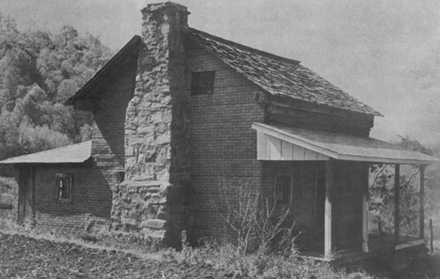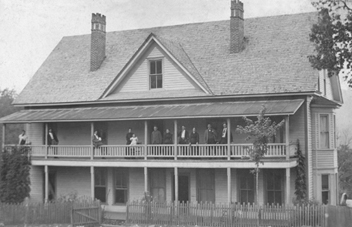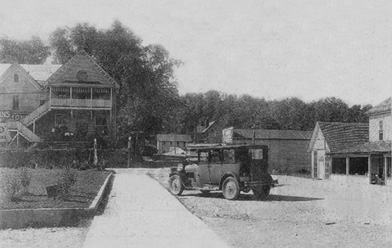
Campbell House, oldest house in the county
|
Inside Fred Ghormley's Store
|
Mauney Hotel, later home of J. B. Cory |

Slaughter Hotel built 1897 |
| Back to the Index | THE TOWN OF ROBBINSVILLE | Back to the Index |
AN ACT TO INCORPORATE THE TOWN OF
ROBBINSVILLE IN GRAHAM COUNTY
The General Assembly of North Carolina Do Enact:
Section 1. That the town of Robbinsville in Graham County be and the same is hereby incorporated under the name and style of the "Town of Robbinsville," and shall be subject to all the provisions contained in chapter sixty-two of the Code, except sections thirty-eight hundred, thirty-eight hundred and seven, thirty-eight hundred and eight, thirty-eight hundred and fifteen and thirty-eight hundred and sixteen.
Section 2. That the corporate limits of said town shall be the same as set forth under the plat of said town under the original charter of the town of Robbinsville in Graham County.
Section 3. That the officers of said town shall consist of four commissioners, and a treasurer who shall be ex-officio clerk of the board of town commissioners, said four commissioners shall chose one of their number mayor, and also their constable and treasurer.
Section 4. That until the officers shall be elected under the general law concerning corporations, N. M. E. Slaughter, G. B. Walker, N. G. Phillips and J. W. King are appointed commissioners of said town with the power to appoint their constable and treasurer to serve until the time prescribed by law for the next election of officers for incorporated towns.
Section 5. That the commissioners of said town shall have power to make all necessary by-laws, rules, and regulations for the good government of said town, not inconsistent with the constitution of this state, or the United States.
Section 6. That this act shall be in force from and after its ratification. Ratified the 27th day of February, A. D. 1893.
The town of Robbinsville was duly incorporated in 1893 with N.M.E. Slaughter as the first mayor. N. M. E. Slaughter was the father of R. B. Slaughter who later served for twenty-two years as Robbinsville mayor. Growth of the town was slow during its early years.
Among the earliest stores were the George Walker store that later became the store which sat where the Joyce Kilmer Service Station was located (now a parking lot) and the Ben Grant store which could boast of a wooden sidewalk which prevented the ladies from walking in the mud during rainy weather. A little later came Fred Ghormley's store which had the first Coke fountain and ice cream parlor in the town of Robbinsville. It was indeed a special treat for young and old to come to town for ice cream. With the coming of the lumbering officials of Belding, Whiting, and other companies, hotel facilities were necessary. Soon after the county was formed Captain N. G. Phillips came to Robbinsville from Valley River near Andrews and built the first hotel. This hotel was operated for several years and known as the Junaluska Inn. Another hotel built about 1880 was the Love Joy Hotel operated by W. F. Cooper. The name Love Joy was supposedly derived from the jolly, friendly manner of its proprietor. Just before the turn of the century the Slaughter Hotel was constructed.

Campbell House, oldest house in the county
|
Inside Fred Ghormley's Store
|
Mauney Hotel, later home of J. B. Cory |

Slaughter Hotel built 1897 |
Yet Robbinsville was still very sparsely populated with many trees and open space. In 1884 the population was just 102; in 1915 - 200. However, in 1926 the little town experienced considerable growth with the purchase of the Graham County Railway by Bemis Lumber Company and the beginning of a common carrier line connecting with Southern Railway at Topton. Bemis also constructed the large lumber plant at East Robbinsville and many houses to care for the workmen and their families. The first hard surfaced road was opened connecting Robbinsville with Topton about the same time. Also in 1925 the town installed a water system costing about $35,000.
Early residence of George Walker in Robbinsville, located where Robbinsville Elementary School is today. |
Oldest House in town of Robbinsville |
In 1928 the town boasted of a complete electric light system, which was operated by the Bemis Lumber Company Plant. The general store of Wiggins and Ammons on one side of the courthouse square was one of the busiest scenes in town. G. C. Gaston became the new editor and publisher of the Graham County News. A new modern two-story brick building was present on the square housing the Graham County Bank, The Davis Drug Store, and the U. S. Post office on the first floor and offices for lawyers and others on the second floor. By this time the town had reached a population of 500.
Original town Library |
Second Library at same location |
Transportation throughout our history has restricted development of commerce and industry. Yet it has enabled us to preserve much of the heritage we cherished, as we in large measure have not felt the pressures that are inherent in a more open free moving society. The roads of today follow many of the paths used by the Cherokee and the trails made by large animals of this once wilderness area. Those paths were only smoothed and widened, in many instances with few alterations in the course taken. The first highway actually was the improvised road through Tatham Gap used in evacuating the Indians in 1838.
Only in the years since the Second World War has the tremendous earth-moving equipment been developed which makes it possible to cut the kind of roads necessary in our mountainous region. We only need look backward in time a short space to the days when 20 miles from sunrise to sunset was really stirring up the dust or slinging the mud as the case may have been. Traveling was not only an adventure in itself but often an ordeal. A brief look at the different stages of development of the Topton road will give some understanding of the process, which was repeated to some extent in the construction of the other highways about the county.
In 1902 R. B. Slaughter of Robbinsville acting in behalf of the county commissioners of Graham County persuaded the Kanawah Hardwood Lumber Company to buy $4,000 worth of "county orders" on which payment would be in the four successive years at 6% interest for the purpose of building an extension of the Tallulah road to Topton, thus giving access to the Murphy Branch Railroad. In 1902 the county property evaluation was $875,566.00; there were no county debts except for $3,100.00 balance on the new jail. A special road tax was levied for construction of the Topton road that was to cost $4,000 as above mentioned. This road was to prove to be a tremendous improvement over the old Andrews road over which the mail had been carried by wagon for years.
Early road building in Robbinsville with first motorized equipment on Main Street
M. L. Krise was appointed general superintendent over construction of this road at a salary of $70.00 per month. As there was no mechanized equipment, the first Topton road was literally dug out of the mountainside with pick and shovel. The road was widened in the years 1922-1925. When this new Tallulah road was built, convict labor was used. Bonds were again issued and state aid was available. Graham County began to emerge from its former isolation. In the late 1950's the present Topton road was built.
Early road building equipment |
Dr. and Mrs. Swinfield Howell in early auto |
One of the greatest celebrations this county has ever experienced was on June 23, 1930 when more than one hundred persons from East Tennessee came to Robbinsville to join the people of Graham County in celebration of the opening of the new highway connecting Robbinsville with Maryville and other towns of Tennessee. Mayor R. B. Slaughter in welcoming the groups pointed out that the new highway gave East Tennessee a southern outlet and Graham County a northern outlet. Lawyers T. M. Jenkins and T. A. Morphew took part in the ceremony. J. E. Cory was appointed on the spot to attempt to get the North Carolina State Highway Commission to oil the new road, which had only a crushed stone surface. The opening of the Tennessee highway signaled the beginning of an era of road building in our county still in progress and the gradual disappearance of many old modes of travel from our midst.
Delegation celebrating opening of US 129 to Tennessee in 1931 in front of second Graham County courthouse |
Graham County Railroad and construction of Topton Highway |
During the less mechanized period of our development the bridge, as we know it, did not exist. Five wooden covered bridges were within a few miles of the town of Robbinsville. The small swinging bridge was common. The foot log was used to cross small streams on private farms.
Swinging bridge near Snowbird School |
1904 construction of covered bridge on Mountain Creek |
Another landmark of our heritage, which has passed, was the river ferry. Columbus Higdon of Tuskeegee operated a ferry of that type prevalent during the early 1900's in our county. The fare at Higdon's Ferry for many years was five cents a crossing. Many wagonloads of lumber were ferried across to Wayside from that point. The lumber was hauled by wagon from Yellow Creek and other areas to the river site on lower Tuskeegee. The Higdon Ferry continued in operation until the coming of Fontana Lake.
Ferry boat crossing at Rocky Point
In 1929-30 a highway was constructed from Robbinsville to Stecoah. In 1955 highway 28 was built from Stecoah to Fontana Dam. In the late 60's the highway down Santeetlah Lake was rebuilt as exists today. The Robbinsville-Tellico road has been partially completed and is presently the subject of much controversy between those seeking its completion and the wilderness lovers who oppose it. Present plans call for the construction of a new highway from Robbinsville to Stecoah soon. Presently a secondary road is being built from Yellow Creek across the mountain to Tuskeegee following the old road, which is now impassable.
Mid-town Robbinsville facing north, about 1930 |

Mid-town Robbinsville facing south, about 1930 |
The changes that have been wrought in our county highway system and its operation can be seen by a look at the career of Virgil Jenkins, retired Superintendent of Roads of Graham County. Jenkins started out his long career with the State Highway Commission as the one-man Superintendent of Old Highway No. 288, with an old truck, a cross-cut saw, axe, pick, shovel, and rock hammer to fill up holes. Deals Gap to Bryson City, some 50 miles, took all day to make the trip. Old 288 as Bob Barker recalls followed the Old State Road or Tennessee River Turnpike in Swain County, almost all the way to present Luada. Almost all of Old 288 is now under the waters of Fontana Dam. Upon retirement of Jenkins, Cecil Hooper became superintendent of roads and headed a well-manned crew equipped with the most modern equipment.
Graham County highway crew in 1972
Graham County Health Center
|
Fort Hill Housing Project
|
Robbinsville Masonic Lodge 672
|
Looking down on Robbinsville by-pass
|
Robbinsville uptown
|
Original Wachovia Bank, now the Sheriff's office
|
Original Northwestern Bank - 1972 |
View from Joanna Bald |